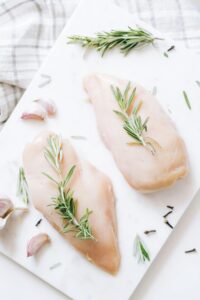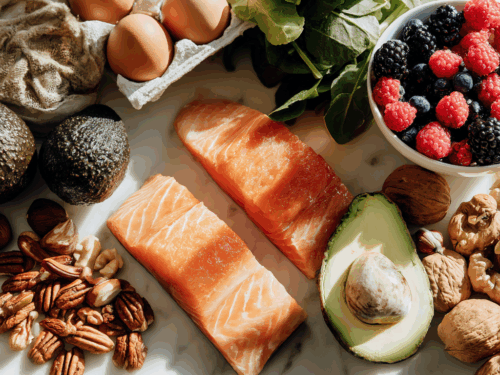I’ll be honest, I’ve always preferred dark meat over white meat. There’s just something about the flavor and tenderness that comes from that bit of extra fat. I’ve always believed that fat = flavor, and honestly, that still holds true for me.
That said, I completely understand why chicken breast is such a popular option. It’s lean, high in protein, and often recommended for people watching their fat intake or following dietary restrictions. But let’s be real, if it’s not cooked properly, chicken breast can turn into a dry, chewy disappointment that no amount of sauce can save.
One of my friends recently told me he was on a chicken breast and broccoli diet because he needed to get his weight under control before a blood test. He was doing his best to eat healthy, but kept complaining about how dry the chicken was. So I shared how I cook chicken breast at home, and how I reheat it later without turning it into rubber.
 Cooking Chicken Breast Properly: It’s All in the Prep
Cooking Chicken Breast Properly: It’s All in the Prep
Here’s how I keep chicken breast juicy and flavorful:
1. Pound It Even
Chicken breasts are usually thicker on one end. I gently pound them out with a meat mallet (or the bottom of a pan) so they cook evenly. This helps prevent the thinner end from drying out before the thicker end is done.
2. Don’t Skip the Brine
If I have a few extra minutes, I soak the chicken breasts in a quick saltwater brine (about 15–30 minutes). This helps the meat retain moisture while cooking.
3. Sear, Then Finish Gently
I start by searing the chicken in a hot pan with a bit of oil for color and flavor, then finish it in the oven or on low heat until the internal temp reaches 165°F (75°C). I also love baking it in foil or parchment to trap steam and lock in moisture.
4. Let It Rest
This part is key: after cooking, I let the chicken rest for 5–10 minutes before slicing. It gives the juices time to redistribute so they don’t all run out the second you cut in.
Why I Recommend Using a Thermometer
One little tool that has truly transformed how I cook chicken breast is a digital meat thermometer. Instead of guessing when the chicken is done (which often leads to overcooking or undercooking), a thermometer gives me peace of mind and precision. When I know the internal temperature is just right, I get that juicy, moist chicken every time, and it also helps me safely reheat leftovers.
Here is a link to the digital meat thermometer I use:

Alpha Grillers Meat Thermometer Digital
-
Fast & Accurate: Instant-read thermometer with 1–2 second response time, pre-calibrated with a meat temperature chart and recalibration option.
-
Versatile Use: Works for grilling, baking, frying, candy making, and more—suitable for ovens, air fryers, BBQs, smokers, and outdoor cooking.
-
Easy to Read: Large digital display with bright blue backlight for visibility in any lighting.
-
Durable & Water-Resistant: IP67-rated design that can be safely washed under running water.
Using a thermometer not only helps me avoid drying out the chicken, but it also ensures food safety, and for me, that’s so worth it.
Reheating Chicken Breast Without the Dry Out
Now here’s the part that’s just as important: reheating.
If you’ve ever microwaved cold chicken breast and ended up with something dry and rubbery… you’re not alone. But you can reheat it so it stays tender.
Here’s how I do it:
- Microwave Method (My Go-To):
- Slice the chicken breast
- Arrange it in a single layer in a microwave-safe dish
- Add a splash of water, chicken broth, or olive oil
- Cover with a damp paper towel or lid
- Heat at 50% power for 1–2 minutes, checking halfway
- Stovetop Method:
- Add sliced chicken to a skillet with a little broth or water
- Cover with a lid
- Heat on low, just until warmed through
- Oven Method (for larger portions):
- Wrap in foil with a bit of moisture (broth, oil, or water)
- Bake at 325°F (163°C) for about 10–15 minutes
It’s Worth the Effort
Whether you’re trying to eat healthier or just want to enjoy leftovers that don’t taste like cardboard, a little bit of technique goes a long way. Even my friend, who was counting every calorie and struggling through plain chicken breast, said it made a huge difference after trying these methods.
I may still lean toward dark meat, but when chicken breast is cooked and reheated right, it’s a solid, satisfying option that can fit into all kinds of meals.
For delicious chicken recipes you can make at home, click here to explore my favorite Plate Me Happy chicken dishes.
Got your own method or favorite seasoning blend for chicken breast? I’d love to hear it!
Affiliate Disclosure:
Some of the links on this page are affiliate links. This means that if you click through and make a purchase, I may earn a small commission at no extra cost to you. Your support helps keep PlateMeHappy.com running so I can continue creating delicious recipes, helpful kitchen tips, and free content for everyone. Thank you so much for supporting my work. It truly means the world to me.



